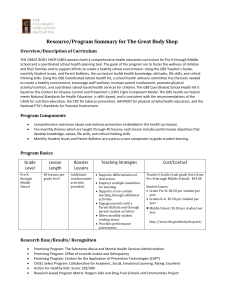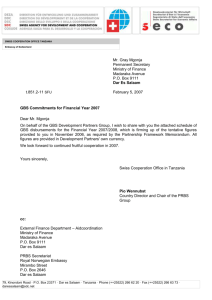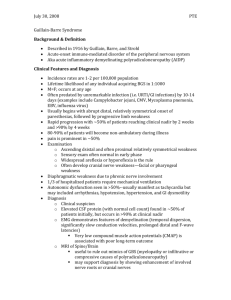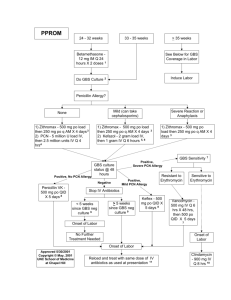general budget support and the gbs process
advertisement
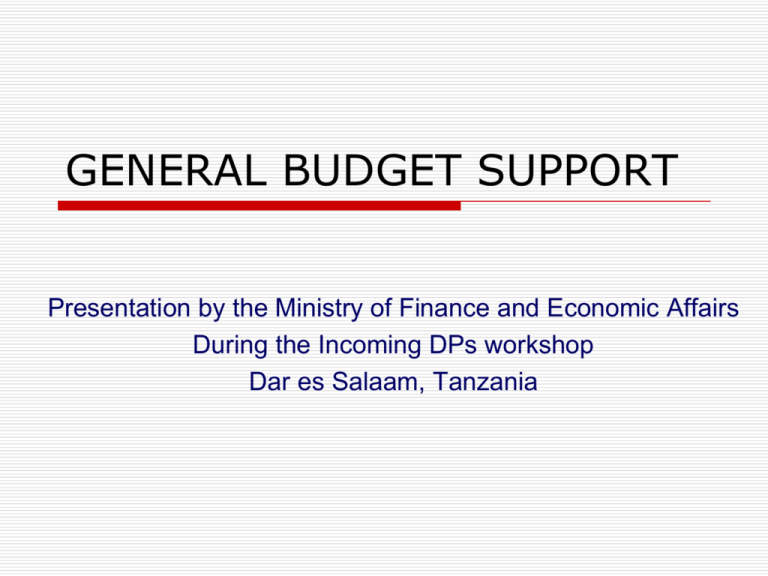
GENERAL BUDGET SUPPORT Presentation by the Ministry of Finance and Economic Affairs During the Incoming DPs workshop Dar es Salaam, Tanzania Contents Aid modalities What is General Budget Support? Advantages of General Budget Support Conclusions INTRODUCTION The Government of Tanzania (GoT) receives aid in 3 different aid modalities I. General Budget Support (GBS) II. Basket Funds (BFs) III. Direct Project Funds (DPFs) TANZANIA OFFICIAL DEVELOPMENT ASSISTANCE GENERAL BUDGET SUPPORT What is General Budget Support? General Budget Support (GBS) is a modality of delivering Official Development Assistance (ODA) as financial assistance to the Government. Other funding modalities that exist in Tanzania are sector budget support, basket (or pooled) funds, and project funds. GBS is provided by Development Partners directly to the national budget and is allocated by the Government according to its own priorities (currently for the implementation of MKUKUTA/MKUZA) in the same way and process as domestic resources. It is hence subjected to the same degree of contestability in the national budget process as domestic resources. TANZANIA OFFICIAL DEVELOPMENT ASSISTANCE GENERAL BUDGET SUPPORT Which Development Partners provide General Budget Support? Currently, 14 Development Partners provide GBS to the Government. They are 11 bilaterals – Canada, Denmark, Finland, Germany, Ireland, Japan, the Netherlands, Norway, Sweden, Switzerland, and the United Kingdom, and 3 multilateral agencies – the African Development Bank, the European Commission, and the World Bank. TANZANIA OFFICIAL DEVELOPMENT ASSISTANCE GENERAL BUDGET SUPPORT How is GBS Delivered and Managed? GBS is fully integrated in the national budget and Exchequer system. GBS commitments are usually recorded in their full amount in the national budget, as they are committed by Development Partners. (GBS is thus far more predictable than other aid modalities, i.e. basket and project funds). GBS funds are treated in the national budget preparation process in the same way as domestic resources (i.e. they are allocated to MDAs, Regions and LGAs through the same process of contestability). They are used to finance MKUKUTA implementation. GBS is disbursed by Development Partners into specific GBS accounts at the Bank of Tanzania and thereafter deposited into the Government Consolidated Fund (Exchequer) accounts, after which it follows the same Government channels and procedures for funding flows as domestic resources. GBS funds can therefore no longer be separately traced in the national budget and Exchequer (accounting) system. Advantages of GBS It provides financial assistance to the overall national budget (Government Consolidated Fund) in line with the (Constitution) Laws of the country. It is allocated by the Government according to its legal and budgetary process and hence subjected to the same degree of contestability as domestic resources Advantages of GBS It strengthens the Parliamentary role for decision making in resource allocation as more external resources will have to adhere to the national (Parliamentary) approval process thus, contributing to shifting Government accountability from donors to citizens through the Parliament It strengthens national public financial management and accountability systems by making use of existing structures and systems It increases the predictability of external resource availability and disbursements by basing funding decisions on outcomes of a joint review Performance Assessment Framework, which takes place prior to the FY in which disbursements are to be made Advantages of GBS It is the only modality that fully complies with the country’s legal budgetary framework, i.e. the Constitution of the URT, Chapter 7, Articles 135 and 136, which require that all revenues/finances must be deposited in the Government’s Consolidated Fund and appropriated by the Act of Parliament – Others use parallel systems It increases the proportion of external resources subjected to the national budget process thereby increasing national ownership, transparency and domestic accountability It strengthens the national budget process by limiting the access of Government agencies to extra budgetary finance by emphasizing national budget as the main framework for identifying priorities and programming resource use Advantages of GBS It contributes to transaction cost reduction, development partners harmonization and the alignment process through the adoption of single process for reviews, assessment, dialogue, etc. It is consistent with the Tanzania Assistance Strategy (2002), Monterrey Consensus (2002), Rome Declaration (2003), Marrakech Memorandum (2004), Paris Declaration (2005) and Joint Assistance Strategy for Tanzania (2006) commitments on aid effectiveness. It provides space for the Government to manage her business within the agreed priorities 3.What is PAF Matrix o o o PAF Matrix is the framework to assess Government performance on an annual basis for the provision of GBS funding It contains Government commitments that have been jointly agreed between the Government and GBS – DPs GBS-DPs decide their GBS funding commitments on the basis of Government performance against the PAF o All GBS-DPs commonly use the PAF as the basis for their funding decisions – no individual/separate criteria What is PAF Matrix PAF Matrix commitments are grouped into four areas: – 1) Growth and Reduction of Income Poverty; 2) Improvement of Quality of Life and Social Well-being; 3) Governance and Accountability); 4) Public Financial Management and Macroeconomic Stability, including Public Expenditure Management PAF Matrix (cont) Commitments listed in the PAF Matrix are grouped into three categories: Underlying processes; usually sector or programme reviews. These reviews consist of an ongoing process of dialogue between the Government, DPs and other stakeholders throughout the year and usually with an annual (or semi-annual) multi-stakeholder review event Temporary process actions are specific actions that the Government commits itself to complete by a specified timeframe before the GBS Annual Review at which Government performance is assessed. Outcome indicators indicators measure broader outcomes in the five areas of the PAF and in most cases are taken from the MKUKUTA Monitoring System. They have baseline values for 2005 and targets for 2010, corresponding to the MKUKUTA targets wherever applicable Progress towards these targets are assessed annually – it is determined whether progress is on track, already achieved, is at risk of being achieved by 2010, or progress is off track Asante Sana


